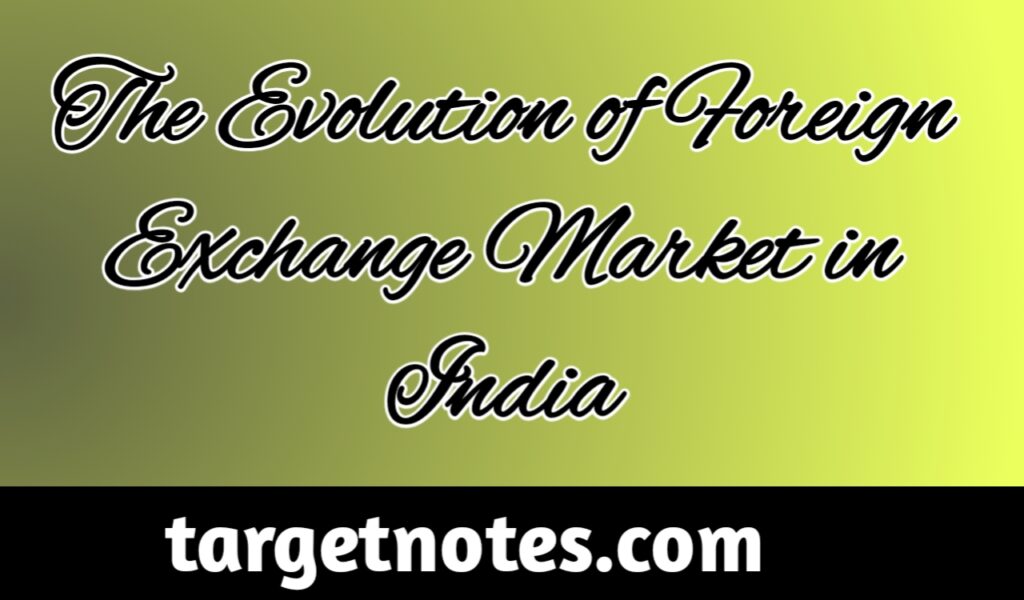
The evolution of foreign exchange market in India
Contents
Discuss the evolution of foreign exchange market in India?
The Indian forex market owes its origin to the important step that RBI took in 1978 to allow banks to undertake intra-day trading in foreign exchange. As a consequence, the stipulation of maintaining “square” or “near square” position was to be complied with only at the close of business each day. During the period 1975-1992, the exchange rate of rupee was officially determined by the RBI in terms of a weighted basket of currencies of India’s major trading partners and there were significant restrictions on the current account transactions.
(i) The initiation of economic reforms in July 1991 saw significant two-step downward adjustment in the exchange rate of the rupee on July 1 and 3, 1991 with a view to placing it at an appropriate level in line with the inflation differential to maintain the competitiveness of exports. Subsequently, following the recommendations of the High Level Committee on Balance of Payments (Chairman:Dr C. Rangarajan) the Liberalised Exchange Rate Management System(LERMS) involving dual exchange rate mechanism was instituted in March 1992 which was followed by the ultimate. convergence of the dual rates effective from March 1, 1993(christened modified LERMS). The unification of the exchange rate of the rupee marks the beginning of the era of market determined exchange rate regime of rupee, based on demand and supply in the forex market. It is also an important step in the progress towards current account convertibility, which was finally achieved in August 1994 by accepting Article VIII of the Articles of Agreement of the International Monetary Fund.
(ii) The appointment of an Expert Group on Foreign Exchange (popularly known as Sodhani Committee) in November 1994 is a landmark in the design of foreign exchange market in India. The Group studied the market in great detail and came up with far reaching recommendations to develop, deepen and widen the forex market. In the process of development of forex markets, banks have been accorded significant initiative and freedom to operate in the market. To quote a few important measures relating to market development and liberalisation, banks were allowed freedom to fix their trading limits, permitted to borrow and invest funds in the overseas markets up to specified limits, accorded freedom to determine interest rates on FCNR deposits within ceilings and allowed to use derivative products for asset-liability management purposes. Similarly, corporates were given flexibility to book forward cover based on past turnover and allowed to use a variety of instruments like interest rates and currency swaps, caps/collars and forward rate agreements in the international forex market. Rupee-foreign currency swap market for hedging longer term exposure has developed substantially in the last few years.
Market Profile
(i) The Indian forex market is predominantly a transaction based market with the existence of underlying forex exposure generally being an essential requirement for market users. Similarly, regulations in most cases require end users to repatriate and surrender foreign exchange in the Indian forex market. All forex transactions of Government of India are routed through the market except for aid transactions.
(ii) The forex market is made up of Authorised Dealers (generally banks), some intermediaries with limited authorisation and end users viz., individuals, corporates, institutional investors and others. Market making banks (generally foreign banks and new private sector banks) account for a significant percentage of the overall turnover in the market.
(iii) The average monthly turnover in the merchant segment of the forex market increased to US$ 40.5 billion in 2003-2004 from US$ 27.0 billion in 2002-2003. In the inter-bank segment, the turnover has moved up from US$ 103 billion in 2002-2003 to US$ 134.2 billion in 2003-2004. Consequently, the average monthly total turnover increased sharply to US$ 174.7 billion in 2003-2004 from US$ 130 billion in the previous year. The inter-bank to merchant turnover ratio hovered in the range of 2.9-3.9 during the year.
IMPORTANT LINK
- What is the Exchange Rate System in India?
- Evolution of foreign exchange market in India
- Meaning and importance of export finance.
- Role of Export-Import Bank in Financing India’s Foreign Trade
- How Commercial banks Export Finance to Overseas Importers?
- Explain packing credit in detail?
- What is Post-shipment credit?
- What is Pre-shipment or packing credit?
- Explain Export Credit in India?
- Institutions Providing Finance and Credit Facility for Foreign Trade
- What is Risk Analysis?
- Explain Political risks in detail? and its Types
- What are the types of Risks. Explain in detail?
- Meaning and Types of commercial risks
- How can we minimize foreign trade risks?
- What are Arbitrage operations?
- Difference between Spot Market and Forward Market
- What is spot exchange?
- Agency agreement: Meaning, Features and Advantages
- Functions of Foreign Exchange markets
- structure of Foreign exchange markets
Disclaimer






